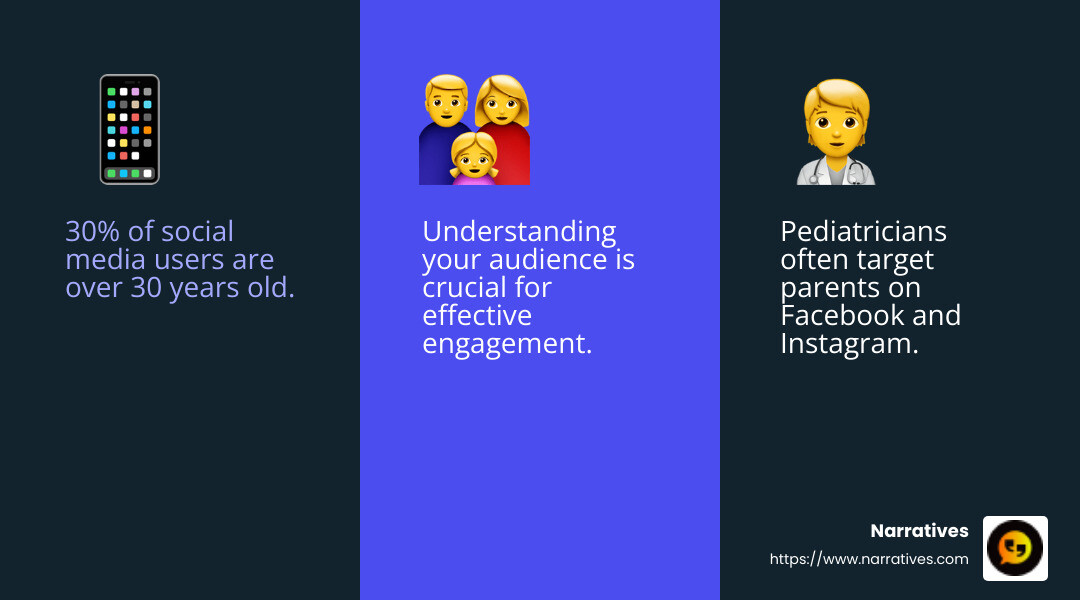Patient Engagement: A Guide to Social Media Marketing for Physicians

Social media marketing for physicians is a game-changer in the landscape of patient engagement and digital marketing. As healthcare professionals seek to build their practices and improve patient communication, social media offers a robust platform to achieve these goals.
Here's a quick look at how social media marketing can benefit physicians:
- Increase Visibility: With 70% of the US population on social media, a strong presence boosts your practice's visibility.
- Establish Trust: 60% of patients trust doctors’ posts online. By sharing reputable content, you build trust and credibility.
- Engage Patients: 41% of patients use social media to choose healthcare providers. Engaging content can guide them to your practice.
- Improve Patient Care: 40% of patients say information found on social media affects treatment decisions.
Social media is more than just a broadcasting channel; it's a two-way street for interaction and relationship-building with your patients. The right strategy can transform how you connect with your community, making your practice a local health authority.
Let's dive deeper into the strategies and tools you can use to create meaningful patient relationships online.

Common social media marketing for physicians vocab:
- social media marketing for b2b companies
- social media marketing for music artists
- social media marketing for saas
Understanding Social Media Marketing for Physicians
Social media marketing for physicians is not just about posting updates or sharing articles. It's about creating a digital space where doctors and patients can connect meaningfully. This involves understanding your audience, crafting the right content, and respecting ethical boundaries.
Audience Targeting
Knowing your audience is the first step in effective social media marketing. Ask yourself: Who are you trying to reach? Are they young adults on Instagram, or older patients on Facebook?
Think about demographics like age, gender, and location. For example, if you're a pediatrician, you might focus on parents using Facebook and Instagram. If you're targeting young adults, platforms like TikTok and Snapchat might be more effective.

Content Creation
Creating content that resonates with your audience is crucial. Content should be informative, engaging, and easy to understand. You can share health tips, answer common questions, or debunk medical myths.
Use a mix of formats like videos, infographics, and articles. Remember to keep your brand voice consistent—whether it's friendly, professional, or authoritative. This helps build trust and makes your practice more relatable.
Here’s a simple content checklist:
- Informative: Share health tips and advice.
- Engaging: Use polls or Q&A sessions.
- Visual: Use images and videos to capture attention.
Ethical Boundaries
Maintaining ethical boundaries is more important than ever. Physicians must ensure patient privacy and adhere to regulations like HIPAA. Avoid sharing any identifiable patient information without consent.
Always be transparent and honest in your communications. If you have partnerships or endorsements, disclose them clearly to maintain trust.
"The Hippocratic Oath still applies in the online field. Keep patient descriptions respectful, and avoid referencing specific cases without explicit consent."
By focusing on audience targeting, content creation, and ethical boundaries, physicians can effectively use social media to engage with patients and build a trusted online presence.
Next, we’ll explore the platforms and tools that can help you connect with your audience effectively.
Platforms and Tools for Physicians
When it comes to social media marketing for physicians, choosing the right platform is crucial. Each platform offers unique features that can help you connect with your patients effectively.
Facebook is a powerhouse for reaching adults aged 30 and above. It's perfect for sharing detailed posts, videos, and updates about your practice. You can also create events, such as health webinars or community outreach programs. Facebook's Groups feature allows you to build a community where patients can ask questions and share experiences.
Pro Tip: Use Facebook Ads to target specific demographics, like women aged 35 to 65 who might be interested in anti-aging treatments.
Instagram is all about visuals. It's ideal for showcasing your practice through images and short videos. If you're a dermatologist, you might share before-and-after photos (with patient consent, of course). Use Instagram Stories to give a behind-the-scenes look at your practice. This platform is particularly effective for engaging with younger adults.
Pro Tip: Use hashtags to increase your reach and engage with a broader audience.
TikTok
TikTok is rapidly gaining popularity, especially among younger demographics. It's a great place for short, engaging videos that offer quick health tips or debunk medical myths. If you're camera-friendly, TikTok can be a fun way to show your personality and make healthcare more approachable.
Pro Tip: Consider starting a series of short videos on a specific health topic to keep your audience coming back for more.
YouTube
YouTube is the go-to platform for long-form videos. It's perfect for educational content, such as explaining complex medical procedures or offering in-depth health advice. YouTube allows you to build a library of content that can serve as a valuable resource for your patients.
Pro Tip: Use keywords in your video titles and descriptions to improve searchability and reach a wider audience.
Google My Business
Google My Business is essential for local search visibility. It helps potential patients find your practice when they search for healthcare providers in their area. Keep your profile updated with your address, phone number, and hours of operation. Encourage patients to leave reviews, as this can significantly influence your practice's reputation.
Pro Tip: Regularly update your profile with posts about your services, upcoming events, or any changes in your practice.
By leveraging these platforms, physicians can effectively engage with their target audience, share valuable content, and build a strong online presence. Next, we'll dive into creating content that not only informs but also captivates your audience.
Creating Effective Content
When it comes to social media marketing for physicians, content is your most powerful tool. Crafting content that informs, engages, and reflects your brand voice is essential to building trust and connection with your audience.
Informative Content
Informative content is the cornerstone of your social media strategy. Patients often seek reliable information online, and your channels can be a trusted source.
Educational Videos and Articles: Share insights on common health concerns or new medical advancements. For example, a short video explaining the importance of annual check-ups or a blog post about managing chronic conditions can be valuable.
Mythbusting: Address common misconceptions in healthcare. For instance, create a post debunking myths about vaccines, which can help educate and reassure your audience.
FAQs: Regularly answer frequently asked questions. This not only provides value but also positions you as an approachable expert.
Engaging Content
Engagement is key to building a loyal online community. Interactive content encourages your audience to participate and connect with your practice.
Polls and Quizzes: Create simple polls or quizzes that invite your audience to share their thoughts or test their knowledge. For example, a poll asking, "How often do you exercise each week?" can spark conversation.
Behind-the-Scenes Content: Offer a glimpse into your daily operations. Share photos or short clips of your team at work or a sneak peek of your practice's new equipment.
Patient Stories: With consent, share patient testimonials or success stories. These narratives can inspire others and highlight the positive impact of your services.
Brand Voice
Your brand voice should be consistent across all content, reflecting your practice's values and personality.
Tone: Decide whether your tone will be professional, friendly, or a mix of both. For instance, a pediatrician might adopt a warm and playful tone, while a specialist might choose a more formal approach.
Consistency: Ensure that your messaging aligns with your practice's mission. This helps build a recognizable and trustworthy brand identity.
Authenticity: Be genuine and transparent in your communication. Authenticity fosters trust and strengthens your relationship with your audience.
By focusing on informative and engaging content that stays true to your brand voice, you'll not only educate your audience but also create meaningful connections. Up next, we'll explore how to build and engage your online community effectively.
Building and Engaging Your Community
Once you've crafted effective content, the next step in social media marketing for physicians is to build and engage your community. This involves maintaining a consistent posting schedule, encouraging patient reviews, and fostering meaningful community interaction.
Posting Schedule
Consistency is crucial when it comes to posting on social media. A regular posting schedule keeps your practice in the forefront of your audience's minds and helps maintain engagement.
Platform-Specific Guidelines: Each social media platform has its own optimal posting frequency. For instance, on Facebook, aim to post three to ten times per week, while Twitter allows for more frequent updates throughout the day.
Content Variety: Mix up your content types to keep things fresh. Share a combination of informative articles, engaging polls, and behind-the-scenes glimpses to cater to different interests.
Scheduling Tools: Use scheduling tools to plan and automate posts. This ensures a steady stream of content without overwhelming your team.
Patient Reviews
Patient reviews are a powerful tool for building trust and credibility. Encouraging reviews not only improves your online reputation but also provides valuable feedback.
Requesting Reviews: After a positive patient interaction, kindly ask for a review on platforms like Google My Business or Facebook. A simple request can lead to more testimonials.
Showcasing Testimonials: With permission, highlight positive reviews or patient stories on your social media channels. This not only celebrates your successes but also reassures potential patients about the quality of your care.
Responding to Feedback: Engage with both positive and negative reviews. Thank patients for their kind words and address any concerns with professionalism and empathy.
Community Interaction
Building a community online is about more than just posting content; it's about fostering connections and interaction.
Engage with Comments: Respond to comments on your posts, whether they're questions, compliments, or concerns. This shows that you value your audience's input and are willing to engage in dialogue.
Host Live Q&A Sessions: Consider hosting live Q&A sessions where followers can ask questions in real time. This interactive approach can boost engagement and provide immediate value to your audience.
Collaborate with Thought Leaders: Partner with other healthcare professionals or thought leaders for joint content or discussions. This expands your reach and brings fresh perspectives to your community.
By maintaining a consistent posting schedule, encouraging patient reviews, and actively engaging with your community, you'll strengthen your online presence and foster a loyal following. Up next, we'll dive into analyzing and adapting your strategy to ensure ongoing success.
Analyzing and Adapting Your Strategy
Once you've established a vibrant community, the next step in social media marketing for physicians is to analyze and adapt your strategy. This ensures you stay relevant and effective in reaching your audience.
Analytics Tools
Using analytics tools is essential to understand how your social media efforts are performing. These tools offer insights that can help refine your strategy.
Google Analytics: This is a powerful tool for tracking traffic from your social media channels to your website. You can see which posts drive the most visitors and adjust your content accordingly.
Platform-Specific Insights: Most social media platforms, like Facebook and Instagram, offer built-in analytics. These show metrics like engagement rates, reach, and demographics of your audience.
Third-Party Tools: Consider tools like Hootsuite or Sprout Social for more detailed analytics and reporting. They offer advanced features like sentiment analysis and competitor benchmarking.
Trend Monitoring
Staying on top of trends is crucial in the world of social media. By monitoring trends, you can keep your content relevant and engaging.
Healthcare Trends: Follow healthcare-specific hashtags and join online communities to see what topics are currently popular among both patients and professionals.
Social Media Trends: Keep an eye on general social media trends, like the rise of video content, to ensure your strategy remains current.
Competitor Analysis: Observe what similar practices are doing successfully. This can provide inspiration and help you identify gaps in your own strategy.
Strategy Adaptation
Adapting your strategy based on analytics and trends ensures continuous improvement and relevance.
Set Clear Goals: Regularly review your social media goals. Whether it's increasing patient engagement or driving more appointments, clear objectives guide your strategy adjustments.
Test and Learn: Experiment with different types of content, posting times, and engagement strategies. Use the data to learn what works best for your audience.
Feedback Loop: Use feedback from your audience to make informed adjustments. If a particular type of content gets more engagement, consider creating more of it.
By leveraging analytics tools, monitoring trends, and adapting your strategy, you'll ensure your social media marketing efforts remain effective and aligned with your practice's goals. Next, we'll address some frequently asked questions about social media marketing for physicians.
Frequently Asked Questions about Social Media Marketing for Physicians
How can physicians define their target audience?
Defining your target audience is crucial for effective social media marketing for physicians. Start by considering the demographics of your current patient base. Are they mostly adults, seniors, or families with children?
Demographic Targeting: Use social media platforms' targeting features to reach specific age groups, genders, and locations. For example, if you specialize in pediatric care, focus on reaching parents in your area.
Interests and Behaviors: Look at the interests and behaviors of your audience. Are they interested in wellness, fitness, or specific medical conditions? Platforms like Facebook allow you to target users based on these interests, making your marketing more precise.
What are the best practices for maintaining patient privacy on social media?
Patient privacy is paramount in healthcare marketing. Here are some best practices to ensure compliance:
HIPAA Compliance: Never share personal health information on social media. This includes patient names, photos, or treatment details without explicit consent.
Patient Consent: If you want to share patient testimonials or success stories, always obtain written consent. Make sure the consent form clearly explains how their information will be used.
Blur Faces and Anonymize Data: If sharing images or case studies, ensure that patient identities are protected. Blur faces and avoid using any identifiable information.
How can social media advertising benefit physicians?
Paid Advertising on social media can significantly boost your practice's visibility and reach. Here's how it can benefit physicians:
Targeted Audience: Social media platforms like Facebook and Instagram offer robust targeting options. You can narrow down your audience by age, location, interests, and even behaviors. This ensures your ads reach those most likely to be interested in your services.
Cost-Effective: Compared to traditional advertising, social media ads can be more cost-effective. You can set your budget and adjust it based on performance.
Measurable Results: Social media advertising provides detailed analytics. You can track metrics like clicks, engagement, and conversions, allowing you to see exactly how your ads are performing.
By defining your target audience, maintaining patient privacy, and utilizing paid advertising, physicians can effectively harness the power of social media marketing.
Conclusion
Narratives is more than just a digital storytelling partner for non-profits—it's a catalyst for social impact and community storytelling. We believe in elevating underrepresented voices and sharing their stories in ways that inspire action and build trust.
Social media marketing for physicians is a powerful tool that can amplify these stories. By engaging with patients on platforms like Facebook, Instagram, and TikTok, healthcare providers can create meaningful connections that go beyond the exam room. These platforms offer unique opportunities to share expertise, educate communities, and advocate for important health issues.
Community storytelling is at the heart of what we do. When physicians share their experiences and knowledge, they contribute to a broader narrative that fosters understanding and empathy. This approach not only improves patient engagement but also strengthens the bond between healthcare providers and the communities they serve.
Together, we can use digital media to make a difference. By partnering with Narratives, physicians can harness the power of storytelling to drive positive change and improve health outcomes. Our media network services are designed to support these efforts, providing the tools and expertise needed to reach and resonate with audiences.
Let's continue to tell stories that matter, create a lasting impact, and build a healthier, more connected world.


